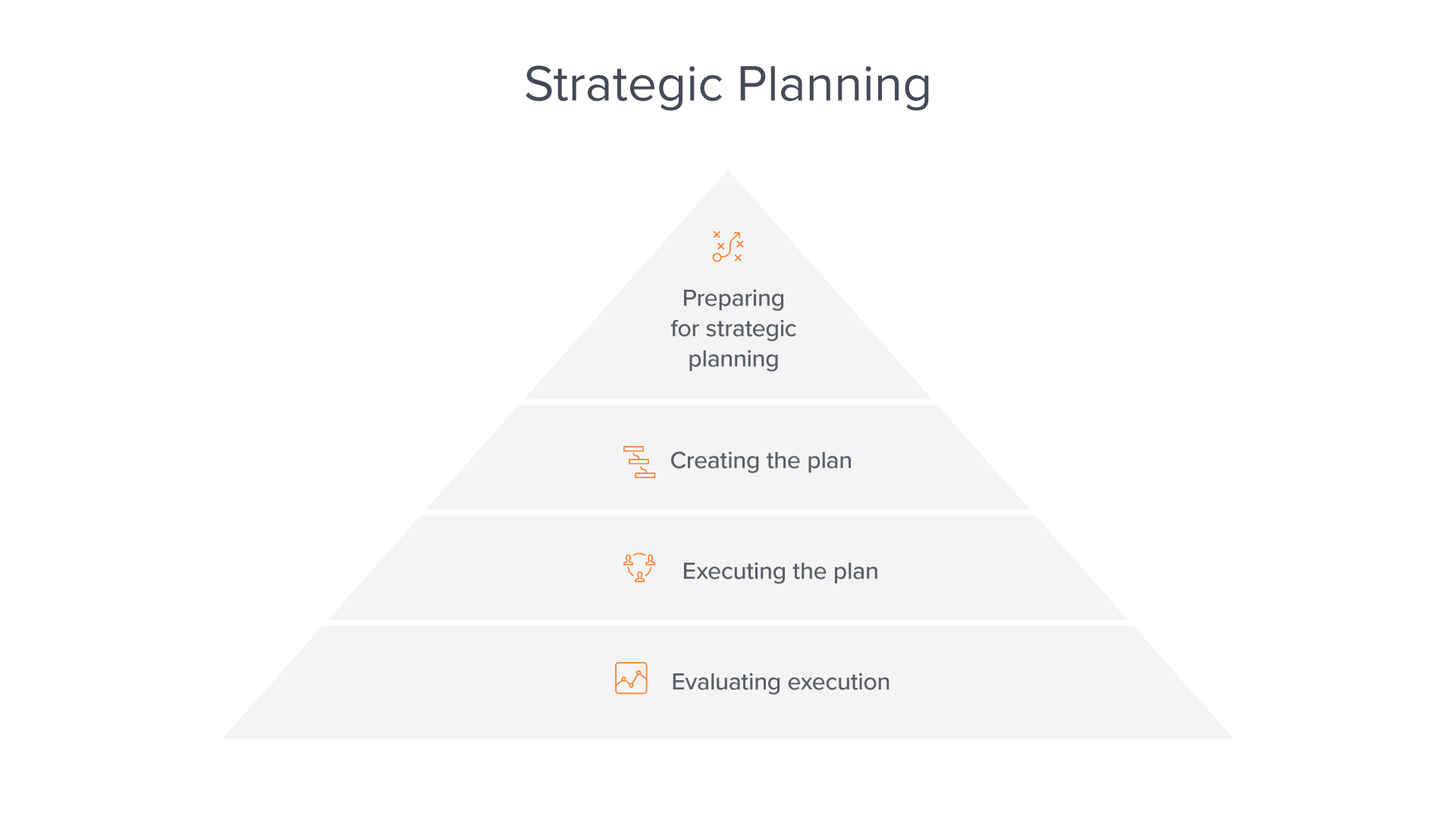#strategic #planning #plan
“Hope is not a strategy, preparation is“–Paul Ebeling
Businesses are prone to immediacy bias. As opportunities and challenges arise, organizations react to what is in the now. And while every company needs to be responsive to current reality, strategic vision very often suffers as a result.
This dynamic is understandable: When your team is immersed in immediate priorities, it is easy to neglect overarching goals.
The Big Qs: How do businesses create space for a more expansive focus? How can companies proactively define their own futures, rather than responding to events as they unfold?
The Big A: Strategic planning.
For many of the world’s most powerful organizations, the answer lies in strategic planning, a deliberate approach to analyzing the present and charting a path forward. In contrast to reactive management, this method empowers companies to assert their own values and goals.
This guide unpacks the core concepts of strategic planning, including its potential benefits and possible risks.
Here you will learn if and when strategic planning makes sense for your business and how to effectively engage your team in the process.
From there, I will present 4 specific phases of strategic planning, from preparation to execution to constructive evaluation. This 4-Step process makes it easier to plan strategically with your team and helps you avoid common pitfalls that might hinder your efforts.
To understand and implement strategic planning for your organization, start by familiarizing yourself with its core concepts and characteristics.
In the language of modern business, the terms “strategic” and “planning” are used so widely that their meanings can become unclear.
Strategic planning is the process of defining your business’s direction, outlining a path from your present toward a preferred future. A strategic plan captures an organization’s mission and core principles, envisioning the fulfillment of these ideals.
Strategic planning is both conceptual and practical, presenting the big-picture goals and specific ways to achieve them.
While strategic plans can be shaped to suit each organization’s needs, they typically include the following elements:
- A comprehensive assessment of the organization’s present, including current successes and struggles
- A clear articulation of the organization’s core purpose and values
- A specific vision of how the organization can change for the better in the future
- A practical plan for achieving change and overcoming potential obstacles
A strategic plan provides a coherent set of targets with which to align your organization’s efforts. In moments of difficulty or indecision, it can be a guiding light, alignment is Key!
Without a strategic plan, an organization cannot proceed collectively toward a shared set of goals. This limitation can impede morale, productivity, and innovation, among other Key aspects of organizational success.
In the absence of strategic clarity, teams may focus on individual indicators, such as revenue, profit, or market share. But none of these metrics are inherently motivating on their own, and colleagues may clash over how to prioritize them.
Strategic planning provides a common vision, enabling team members to separate themselves from their daily duties and consider larger questions. When workers get bogged down in the minutia of their roles, the risk of burnout increases.
Strategic discussions help each person contextualize their work within a larger purpose, driving higher levels of engagement and meaning.
In addition, strategic planning entails a thorough assessment of strengths and weaknesses. Rather than continuing ineffective tactics out of habit, teams that engage in strategic planning are able to pivot toward what actually works.
But perhaps the most important benefit of strategic planning is your organization’s chance to determine its destiny. By candidly assessing its present and collectively embracing a different vision, a company can chart its own course. The alternative is a strategy determined by default: Your organization will be shaped by external forces, not its own aims and principles.
You will be glad to know that strategic planning can work in any industry, for companies large and small. The advantages of a strategic plan can be equally evident at a Fortune 500 company and a recently founded startup.
But, strategic planning requires certain conditions and levels of commitment to succeed. Moreover, certain misconceptions can cloud the process from the beginning, and counterproductive team dynamics can undermine its results.
Set your team up for success.
To successfully engage in strategic planning, you must create the following dynamics within your team:
- Dedicated time and space: Expect your strategic planning session to take several hours of undivided attention from multiple, if not all team members.
- Respectful and transparent communication: Encourage team members to openly voice constructive criticism and truthfully discuss strengths and weaknesses. If respectful but honest communication patterns are not in place, this dialogue can be derailed by hard feelings or pulled punches.
- Accountability and acceptance: Your teams will need to assess their own shortcomings and identify room for improvement. Accordingly, participants must be willing to take accountability for what is not working and listen to others’ struggles without shaming or blaming them.
- Inclusive approach: A strategy determined by a small cohort within your company may not resonate with the larger group. Incorporate perspectives from all corners of your organization to enhance the scope and efficacy of your strategy.
- Data and fact-finding: Much of the strategic planning process revolves around analyzing shared information to draw new conclusions. To inform your strategic planning, develop Key metrics and make them accessible to all involved.
The strategic planning process benefits from inclusivity. When varied perspectives are represented, new insights and possibilities emerge. However, in larger organizations, it may not be feasible or practical for all team members to participate in strategic planning discussions.
In cases where a set of company leaders will compose a strategic plan, gather the unvarnished opinions from your broader team by other means, such as surveys or interviews.
Plus, you may wish to look beyond your full-time team to inform your strategy. The experiences of clients, customers, and collaborators can shed new light on an organization’s strengths and weaknesses.
As you consider all potential sources of input, make sure your core strategic planning team includes leaders from across your organizational structure. These stakeholders could include:
- Department heads, directors, or team leads
- Executives at the VP or C-suite level
- Founders, board members, and major investors
There is no universal playbook: the form and degree of involvement from all of these different parties will vary from company to company, depending on your structure and needs.
Now that I have covered general aspects of strategic planning, let’s discuss its specific stages more thoroughly. The strategic planning process is best understood in terms of four specific phases, each with important constituent elements.
The sections below provide detailed guidance on generating, implementing, and evaluating a strategic plan.
- In the strategic planning process, plotting future successes requires an accurate understanding of your present. You cannot plan a journey without knowing where you’re starting from. Preparation is Key and can set the tone for all your subsequent discussions. To analyze your organization’s present, you’ll need data. As much of it as possible, including statistical, anecdotal, and historical information.
- A strategic plan should capture the very heart of a business, articulating its distinct character. Accordingly, a mission statement is a crucial inclusion in any strategic plan. A mission statement describes what your organization does and how it differs from competitors. A strong mission statement can also convey a business’s reason for being and the distinct value it provides. There are several ways to express an organization’s mission, do not overcomplicate the concept.
- Strategic planning is not an academic exercise. You do it to generate real results. Once you are comfortable with your strategic plan, it is time to put it into action. Execution is never perfect. Even the most talented teams encounter roadblocks when implementing strategic plans.
- The final stage of the strategic planning process involves evaluating the execution of your strategic plan in retrospect. This kind of post-mortem assessment can be extremely informative and help shape future strategic planning. After all, the results of your last strategic planning make great inputs for your next 1.
As you use my high-level overview of the strategic planning process to guide your organization’s efforts, remember that there’s no 1-size-fits-all approach for such an important undertaking. Be sure to tailor each element to the nature of your business and your particular team.
The power of strategic planning lies in its universal applicability and adaptability. No matter your obstacles and opportunities, these principles and practices can help move your company forward.
Have a healthy, prosperous weekend, Keep the Faith!









